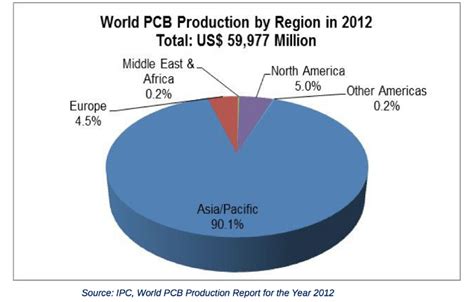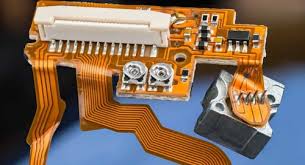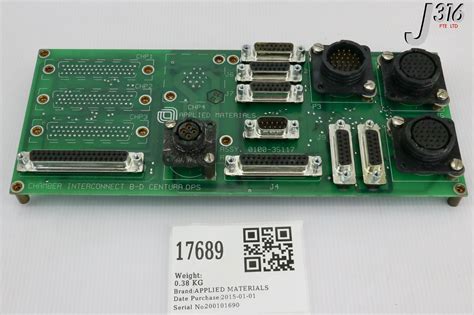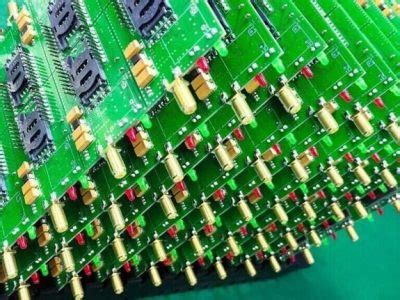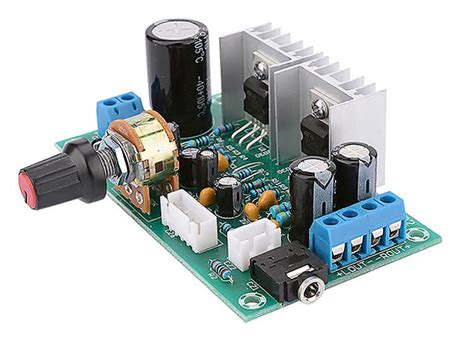Global Electronics Leaders: Top 10 PCB Manufacturers Worldwide

Key Takeaways
When exploring PCB manufacturing leaders, you’ll find that PCB manufacturing companies prioritize three core factors: innovation, cost efficiency, and geographic reach. The PCB manufacturing cost varies significantly across regions, with Asian hubs like Shenzhen and Taipei offering competitive pricing due to economies of scale, while North American and European firms focus on high-mix, low-volume production for specialized industries.
"Choosing the right PCB manufacturing business partner requires balancing technical capabilities with supply chain reliability," advises a 2023 industry report by Electronics Sourcing Journal.
Here’s a quick comparison of leading regions and their specialties:
| Region | Specialty | Average Cost Per Sq. Ft. | Key Players |
|---|---|---|---|
| Asia-Pacific | High-volume, rigid PCBs | $8–$15 | Unimicron, TTM |
| North America | Aerospace-grade flexible | $25–$40 | Sanmina, Flex Ltd. |
| Europe | Automotive HDI solutions | $20–$35 | AT&S, Würth Elektronik |
For startups, optimizing PCB manufacturing cost often means partnering with hybrid providers that combine automated workflows with regional tax incentives. Meanwhile, established enterprises prioritize thermal management and signal integrity in HDI designs. Always verify certifications like ISO 9001 and IATF 16949 to ensure compliance with global standards.
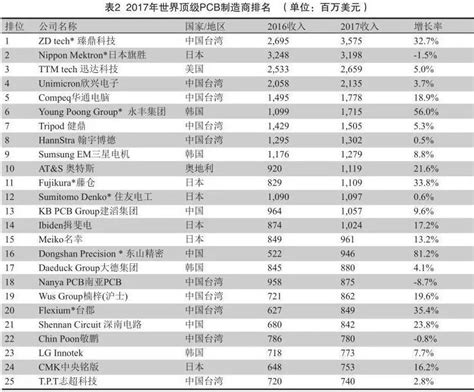
Global Electronics Industry Leaders Revealed
When evaluating the PCB manufacturing landscape, you’ll find a mix of established giants and agile innovators dominating the global stage. Companies like TTM Technologies, Unimicron, and Shennan Circuits lead in both scale and technological prowess, offering solutions that balance PCB manufacturing cost efficiency with cutting-edge capabilities. Asia-Pacific remains the epicenter, hosting over 60% of the world’s PCB manufacturing companies, driven by high-volume production hubs in China, Taiwan, and South Korea. Meanwhile, North American and European firms excel in specialized sectors like aerospace-grade boards, leveraging advanced automation to offset regional labor expenses.
For businesses optimizing their PCB manufacturing business strategy, understanding regional strengths is critical. For instance, Samsung Electro-Mechanics has pioneered high-density interconnect (HDI) techniques, while European players focus on sustainable production methods to meet stringent environmental regulations. Whether you prioritize cost, innovation, or compliance, aligning with these leaders ensures access to rigid, flexible, and multilayer PCB technologies shaping tomorrow’s devices. As you explore partnerships, consider how these manufacturers’ R&D investments—often exceeding 8% of annual revenue—translate into tangible advantages for your projects.
2023 PCB Innovations Reshaping Electronics
As you explore advancements in PCB manufacturing, 2023 stands out for breakthroughs balancing performance and PCB manufacturing cost. Leading PCB manufacturing companies now deploy additive manufacturing techniques, enabling finer trace widths below 15µm while reducing material waste by up to 40%. This shift not only lowers production expenses but also supports compact designs for wearables and IoT devices—critical as demand grows for high-density interconnects (HDIs).
Another game-changer is the rise of embedded component technology, where passive elements integrate directly into substrate layers. This innovation slashes assembly steps, accelerates prototyping, and strengthens reliability in aerospace and automotive applications. For PCB manufacturing businesses, adopting these methods means staying competitive in markets prioritizing miniaturization and energy efficiency.
You’ll also notice smarter automation in factories, with AI-driven inspection systems achieving defect detection rates above 99.5%. Such precision minimizes rework costs—a key factor when scaling PCB manufacturing for 5G infrastructure or AI hardware. Meanwhile, advancements in sustainable substrates (like bio-based resins) address environmental regulations without compromising thermal stability.
These innovations collectively redefine how PCB manufacturing companies approach design flexibility and lifecycle costs, ensuring they meet both technical demands and evolving client expectations in a rapidly digitizing world.
Global PCB Giants: Manufacturing Compared
When evaluating PCB manufacturing capabilities across industry leaders, you’ll notice stark contrasts in specialization and scale. Companies like TTM Technologies dominate high-volume production for aerospace and automotive sectors, leveraging economies of scale to optimize PCB manufacturing cost, while Unimicron focuses on precision HDI PCBs for smartphones and wearables. Regional advantages also play a role: East Asian PCB manufacturing companies often integrate vertically, controlling raw material sourcing to reduce expenses, whereas North American firms prioritize rapid prototyping for niche markets.
The PCB manufacturing business isn’t just about volume—it’s about adaptability. For instance, Shennan Circuits combines automated factories with AI-driven quality checks to balance speed and accuracy, whereas European players like AT&S emphasize eco-friendly processes to meet stringent regulations. When comparing rigid vs. flexible PCB leaders, you’ll find companies like Flexium allocate over 60% of their capacity to flexible circuits for foldable devices, while traditional manufacturers stick to rigid boards for industrial applications.
Cost structures reveal deeper insights: labor accounts for 18–25% of PCB manufacturing cost in Western hubs but drops below 12% in automated Asian facilities. However, tariffs and logistics complexities can offset these savings. As you assess these giants, consider how their strategies—whether scaling production, adopting green tech, or diversifying product lines—shape their competitive edge in a $80+ billion market.
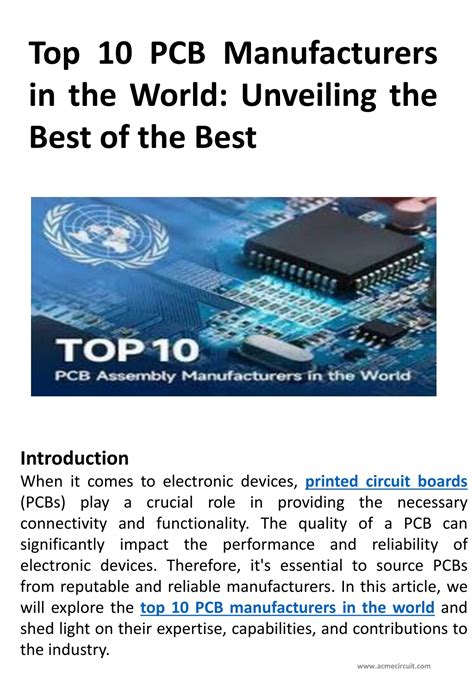
Tech Hubs Driving PCB Production Worldwide
When exploring PCB manufacturing ecosystems, you’ll find concentrated clusters of innovation and production across key regions. Asia-Pacific dominates with hubs like Shenzhen and Taiwan, where PCB manufacturing companies leverage advanced automation and economies of scale to optimize PCB manufacturing cost. These regions benefit from integrated supply chains, skilled labor, and government incentives, making them vital for high-volume production. Meanwhile, North America’s Silicon Valley and Germany’s Bavaria focus on specialized high-mix, low-volume operations, catering to aerospace and medical industries where precision outweighs cost considerations.
Emerging tech corridors in South Korea and Eastern Europe are gaining traction, blending competitive labor rates with growing expertise in flexible PCB and HDI technologies. These hubs address rising demand for compact, high-performance electronics while balancing PCB manufacturing business sustainability through renewable energy adoption. Notably, the EU’s Green Deal and Japan’s circular economy initiatives are pushing manufacturers to innovate eco-friendly processes—a shift reshaping global PCB manufacturing cost structures. By understanding these regional dynamics, you gain insight into how geographic specialization fuels both innovation and market competition.

Rigid vs Flexible PCB Leaders Analyzed
When evaluating PCB manufacturing leaders, understanding the distinction between rigid and flexible circuit boards is critical. PCB manufacturing companies like TTM Technologies and Unimicron dominate the rigid PCB sector, catering to high-reliability applications such as automotive systems and industrial equipment. Their expertise lies in optimizing PCB manufacturing cost through economies of scale, leveraging advanced etching and multilayer stacking technologies.
On the flexible side, innovators like Flexium and Multi-Fineline excel in producing ultra-thin, bendable circuits for wearables and foldable devices. While PCB manufacturing business models here prioritize precision and material innovation (e.g., polyimide substrates), costs are inherently higher due to specialized processes. However, flexible PCBs often offset expenses by reducing assembly steps in compact designs.
Your choice between these leaders hinges on application demands: rigid PCBs for durability in harsh environments versus flexible variants for space-constrained, dynamic use cases. Leading manufacturers now hybridize both technologies, offering rigid-flex solutions that merge cost efficiency with design versatility—a strategic response to evolving electronics demands.

HDI PCB Tech Advancements 2023
As electronics demand smaller, faster, and more reliable devices, PCB manufacturing companies are pushing the boundaries of high-density interconnect (HDI) technology. In 2023, advancements like stacked microvias and laser-drilled interconnects enable circuit densities previously unattainable, allowing for ultra-compact designs in smartphones, wearables, and AI hardware. Leading manufacturers now integrate 10-layer HDI boards with line widths under 40µm—critical for 5G infrastructure and IoT devices.
While PCB manufacturing costs traditionally rise with complexity, innovations in semi-additive processes (SAP) and advanced substrate materials are streamlining production. You’ll find companies leveraging AI-driven quality control systems to reduce defects by up to 30%, balancing precision with scalability. This shift not only supports high-volume PCB manufacturing business models but also addresses sustainability through reduced material waste.
However, adopting HDI tech requires reevaluating supply chains. Low-loss dielectrics and high-frequency laminates often depend on specialized suppliers, influencing both timelines and budgets. For industries like automotive or medical tech, where reliability is non-negotiable, partnering with PCB manufacturing leaders who prioritize R&D ensures access to cutting-edge solutions without compromising performance. The result? A new era of electronics where miniaturization meets unmatched functionality.

Circuit Board Market Trends 2023
As we move through 2023, the pcb manufacturing sector is navigating a landscape shaped by evolving demand and technological shifts. You’ll notice that 5G infrastructure deployments and IoT device proliferation are driving unprecedented growth, with the global PCB market projected to exceed $89 billion by year-end. This expansion isn’t uniform—while traditional rigid PCBs still dominate industrial applications, flexible circuits are gaining traction in wearables and medical devices, reflecting broader consumer trends toward compact, portable tech.
A key challenge for pcb manufacturing companies lies in balancing scalability with pcb manufacturing cost pressures. Rising copper prices and supply chain bottlenecks have forced businesses to rethink sourcing strategies, with many shifting toward regionalized production hubs. What’s particularly notable is how AI-driven automation is reshaping workflows—advanced analytics now optimize material usage, reducing waste by up to 18% in leading facilities.
For those managing a pcb manufacturing business, staying competitive means prioritizing high-density interconnect (HDI) capabilities, especially as automotive electrification demands finer circuitry. Meanwhile, sustainability metrics are becoming a differentiator: 63% of OEMs now require suppliers to meet circular production standards, pushing manufacturers to adopt greener chemistries and recycling protocols. This efficiency gain isn’t just ethical—it directly impacts your bottom line by aligning with stricter global regulations.
Sustainable PCB Manufacturing Methods Explored
As environmental concerns reshape industries, PCB manufacturing companies are adopting methods to minimize ecological footprints without compromising quality. Modern approaches focus on reducing energy consumption through optimized production workflows and renewable energy integration. For instance, leading manufacturers now utilize water recycling systems and lead-free soldering processes, cutting hazardous waste by up to 40% compared to traditional methods.
Balancing PCB manufacturing cost with sustainability often involves material innovation. Bio-based substrates and halogen-free laminates are gaining traction, offering comparable performance to conventional materials while lowering carbon emissions. You’ll find companies investing in closed-loop manufacturing—reclaiming copper from scrap boards—to reduce raw material dependence.
For PCB manufacturing businesses, adopting these practices isn’t just ethical—it’s strategic. Clients increasingly prioritize suppliers with ISO 14001 or UL ECOLOGO certifications, creating market differentiation. Transitioning to solar-powered facilities or partnering with e-waste recyclers can also align with global ESG (Environmental, Social, Governance) benchmarks.
However, scaling sustainable PCB manufacturing requires upfront investments. Advanced filtration systems and employee training add initial expenses, but they often yield long-term savings through regulatory compliance and operational efficiency. As circular economy principles take hold, innovators are even exploring biodegradable circuit boards—hinting at a future where electronics leave minimal environmental traces.
Conclusion
As you evaluate PCB manufacturing partners for your electronics projects, remember that leading PCB manufacturing companies balance technological expertise with operational scalability. The evolving landscape requires manufacturers to address both precision engineering and cost-effectiveness, particularly when managing PCB manufacturing cost across high-volume orders. While established players dominate key tech hubs, emerging innovators are redefining PCB manufacturing business models through sustainable practices and AI-driven quality control.
Your selection criteria should consider not just technical specifications, but also supply chain resilience and environmental compliance—factors increasingly influencing global procurement decisions. Whether prioritizing rigid boards for industrial applications or flexible circuits for wearable tech, aligning with manufacturers investing in material science advancements ensures future-proof solutions. As market demands shift toward miniaturization and IoT integration, these industry leaders demonstrate how strategic R&D investments translate into competitive advantages across aerospace, automotive, and consumer electronics sectors.
FAQs
How do global pcb manufacturing companies maintain quality across international operations?
Leading manufacturers implement ISO-certified processes and automated optical inspection systems, ensuring consistent standards whether producing rigid boards in Asia or flexible circuits in North America.
What factors most impact pcb manufacturing cost for advanced HDI designs?
Layer count, material selection (like high-frequency laminates), and precision requirements for microvias can increase costs by 25-40% compared to standard boards. Manufacturers offset this through economies of scale in high-volume production hubs.
Can small businesses compete in the pcb manufacturing business against industry giants?
Specialization is key. Niche players thrive by focusing on rapid prototyping, low-volume/high-mix orders, or sustainable practices – areas where larger corporations may have slower response times.
How do geopolitical shifts affect pcb manufacturing supply chains?
Recent trade policies have accelerated regionalization, with manufacturers establishing dual sourcing strategies and localized warehouses to mitigate tariff impacts and component shortages.
Ready to Partner with PCB Manufacturing Experts?
For tailored solutions balancing cost-efficiency and cutting-edge technology, please click here to connect with certified global partners.
What certifications should you prioritize when selecting pcb manufacturing companies ?
Beyond ISO 9001, look for UL listing for safety compliance and ITAR registration if aerospace/military applications. Environmental certifications like IPC-1401 demonstrate commitment to sustainable practices.
How are manufacturers addressing pcb manufacturing waste challenges?
Top firms now deploy closed-loop water systems and metal recovery processes, reducing landfill contributions by up to 70% while meeting RoHS and REACH regulatory benchmarks.

